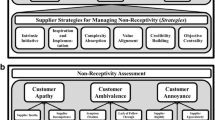Abstract
This study investigates the question of when a customer firm’s participation is helpful or harmful for value cocreation in professional services. Codevelopment between customer and supplier firms is an overlooked research area in the supply chain literature. Further, when there exist no common language and clear rules between suppliers and their customers, the presence of ambiguity is unavoidable. Thus, the investigation of what role ambiguity plays out that affects customer participation and value cocreation is rather imperative. The objective of this research is to answer the following question: How does customer participation (depth and breadth) moderated by ambiguity (need based and knowledge based) affect strategic collaboration, which in turn affects service cocreation outcomes?
Access this chapter
Tax calculation will be finalised at checkout
Purchases are for personal use only
Similar content being viewed by others
References
Bensaou, M., & Venkatraman, N. (1995). Configurations of interorganizational relationships: A comparison between U.S. and japanese automakers. Management Science, 41(9), 1471–1492.
Bowersox, D. J., Closs, D. J., & Drayer, R. W. (2005). The digital transformation: Technology and beyond. Supply Chain Management Review, 91(1), 22–29.
Carson, S. J., Madhok, A., & Wu, T. (2006). Uncertainty, opportunism, and governance: The effects of volatility and ambiguity on formal and relational contracting. The Academy of Management Journal, 49(5), 1058–1077.
Chen, I. J., Paulraj, A., & Lado, A. A. (2004). Strategic purchasing, supply management, and firm performance. Journal of Operations Management, 22(5), 505–523.
Churchill, G. A., Jr. (1979). A paradigm for develo** better measures of marketing constructs. Journal of Marketing Research, 16(1), 64–73.
Daft, R. L., & Macintosh, N. B. (1981). A tentative exploration into the amount and equivocality of information processing in organizational work units. Administrative Science Quarterly, 26(2), 207–224.
Fang, E. (2008). Customer participation and the trade-off between new product innovativeness and speed to market. Journal of Marketing, 72(4), 90–104.
Fang, E., Palmatier, R. W., & Evans, K. R. (2008). Influence of customer participation on creating and sharing of new product value. Journal of the Academy of Marketing Science, 36(3), 322–336.
Flynn, B. B., Huo, B., & Zhao, X. (2010). The impact of supply chain integration on performance: A contingency and configuration approach. Journal of Operations Management, 28(1), 58–71.
Johnson, J. L. (1999). Strategic integration in industrial distribution channels: Managing the interfirm relationship as a strategic asset. Journal of the Academy of Marketing Science, 27(1), 4–18.
Kim, D., & Lee, R. P. (2010). Systems collaboration and strategic collaboration: Their impacts on supply chain responsiveness and market performance. Decision Sciences, 41(4), 955–981.
King, A. W. (2007). Disentangling interfirm and intrafirm causal ambiguity: A conceptual model of causal ambiguity and sustainable competitive advantage. The Academy of Management Review, 32(1), 156–178.
Lau, A. K. W., Tang, E., & Yam, R. C. M. (2010). Effects of supplier and customer integration on product innovation and performance: Empirical evidence in Hong Kong manufacturers. Journal of Product Innovation Management, 27(5), 761–777.
Lee, G., & **a, W. (2010). Toward agile: An integrated analysis of quantitative and qualitative field data on software development agility. MIS Quarterly, 34(1), 87–114.
Li, D., Chau, P. Y. K., & Lai, F. (2010). Market orientation, ownership type, and e-business assimilation: Evidence from chinese firms. Decision Sciences, 41(1), 115–145.
Lippman, S. A., & Rumelt, R. P. (1982). Uncertain imitability: An analysis of interfirm differences in efficiency under competition. Bell Journal of Economics, 13(2), 418–438.
Meuleman, M., Lockett, A., Manigart, S., & Wright, M. (2010). Partner selection decisions in interfirm collaborations: The paradox of relational embeddedness. Journal of Management Studies, 47(6), 995–1019.
Reed, R., & Defillippi, R. J. (1990). Causal ambiguity, barriers to imitation, and sustainable competitive advantage. The Academy of Management Review, 15(1), 88–102.
Vargo, S. L., & Lusch, R. F. (2004). Evolving to a new dominant logic for marketing. Journal of Marketing, 68(1), 1–17.
Williamson, O. E. (1981). The economics of organization: The transaction cost approach. American Journal of Sociology, 87(3), 548–577.
Author information
Authors and Affiliations
Corresponding author
Editor information
Editors and Affiliations
Rights and permissions
Copyright information
© 2017 Academy of Marketing Science
About this paper
Cite this paper
Lee, R.P., Yonggui, W., Ma, S., Anderson, J. (2017). Customer Participation in Service Cocreation: An (Extended) Abstract. In: Stieler, M. (eds) Creating Marketing Magic and Innovative Future Marketing Trends. Developments in Marketing Science: Proceedings of the Academy of Marketing Science. Springer, Cham. https://doi.org/10.1007/978-3-319-45596-9_76
Download citation
DOI: https://doi.org/10.1007/978-3-319-45596-9_76
Published:
Publisher Name: Springer, Cham
Print ISBN: 978-3-319-45595-2
Online ISBN: 978-3-319-45596-9
eBook Packages: Business and ManagementBusiness and Management (R0)




